I owe a lot to olive oil. It’s nourished my body, my soul and not least of which, prevented me from having stretch marks when I was pregnant. At least that’s what my tiny, powerhouse of an Italian Grandmother, Carmela promised all the women in the family it would do if we faithfully rubbed the potent elixir on our expanding bellies every day. And it worked.
Not sure if it was entirely the olive oil or my youthful skin resilience. But since then, I’ve slathered olive oil on my face, my hair and any dry skin patches that don’t respond to crazy expensive store bought lotions.
Olive oil is perhaps Nature’s greatest gift. It keeps us young and healthy, from the inside, out.
The people of the Mediterranean began to emerge from barbarism when they learnt to cultivate the olive and the vine
Greek historian Thucydides
Just as Umbria is the heart of Italy, olive oil is the region’s lifeblood. In fact, olive oil production has been traced to 5 B.C., when the Etruscans first laid claim to the area, followed in violent pageantry by the Romans. The verdant elixir is the base of all Umbrian cuisine and Trevi is the olive oil capital of Umbria.
Olive groves strewn alongside Trevi’s rocky hillside must persevere to grow. It is said the heartiness of the olives is a trait shared by the Umbrian people. They are a people of the land and they are more than happy to share it. Many of them do so by transforming their family homes into agriturismo or licensed tourist farms. Here visitors can eat and drink off the land and taste some of the best-produced olive oil in the world.
Olive oil – as old as time
Olive oil production may have a long and storied history dating back millennia but even the mighty olive tree suffered in the dark days following the collapse of the Roman Empire. During the long period of wars and famine, cultivating olive trees took a back seat to simple survival. At that time, the care of cultivation fell mainly to friars tending private gardens in abbeys and monasteries. This is mainly why you’ll find a plethora of olive tree images in frescoes and painting dating from the 14th century through the Renaissance. Few images are as iconic to Italy as the olive tree.

I find the sheer fortitude of the mighty olive tree fascinating. Legend has it there is an olive tree still standing not far from our home in Paciano that Saint Francis of Assisi himself would sit under and meditate the day away some 800 years ago.
Today, two famous olive trees lay claim to fame as being the world’s oldest. One in Chania, Greece has been producing fruit for thousands of years. Tree ring analysis places it at 2,000 years old yet some scientists say it is much older; more like 4,000 years. The other is the Al Badawi tree in Bethlehem, dating back an incredible 4,000 – 5,000 years. There is no doubt that some of the world’s oldest trees live in the Garden of Gethesmane. It is thought likely that some were present on that fateful night Jesus sought comfort in the garden just before he was crucified.
The incredible olive tree has been a silent, stoic witness to historical events throughout millennia. Today, olive oil production remains an important industry. Although this region provides only about 3% of Italy’s entire production, the quality is considered to be superb. For the olive oil connoisseur, this region is divided into 5 different olive oil areas, falling under the label of DOP (Denominazione di Origine Protetta) Umbria:
- Colli Martani: area located in central Umbria, near Todi. The most important olive tree varieties are: Moraiolo, Frantoio, Leccino and the very rare San Felice.
- Colli Amerini: in southern Umbria with its indigenous Rajo variety, together with Leccino and Frantoio.
- Colli Orvietani: on the western part including Moraiolo, Frantoio and Leccino varieties
- Colli Assisi-Spoleto: on the north-eastern part with Moraiolo, Frantoio and Leccino
- Colli del Trasimeno: around the area of Lago Trasimeno, including here Paciano. You find the native and rare variety Dolce Agogia.
In fact, one of the world’s best rated olive oils is produced right here in Paciano at Il Fontanaro, taking home the Gold medal for two years in a row in New York and London.
https://bestoliveoils.com/brands/olio-fonte-della-pace
A discerning olive oil palate
Years ago, I was treated to my first professional olive oil tasting at Le Due Torri agriturismo near the hill town of Spello. I had no idea then that just like fine wine, olive oil has distinct characteristics.
As the peppery thickness oozed over our tongues we learned to search for flavors of green grass, mature tomato and fresh almond. Positive aspects to look for are fruity, bitter, and pungent. On the not-so-good side, watch for hints of musty, sour or metallic flavors.
We swirled our glasses, smacked our lips and came away with a new appreciation for the complexities of one of Italy’s greatest treasures.
It’s harvest time in Umbria
The olive harvest is hands-down one of my favourite times to be in Umbria (okay those who know me well will challenge this and remind me that Christmas wreath-making in Paciano is my favourite. Let’s call it a draw)
The harvest gets underway anywhere from mid-October to the beginning of November, a glorious time in Umbria. The sun is warm, not scorching. The air carries a hint of wood-smoke from the first home fires of the season. The countryside shimmers with an array of green and gold. Pure magic.
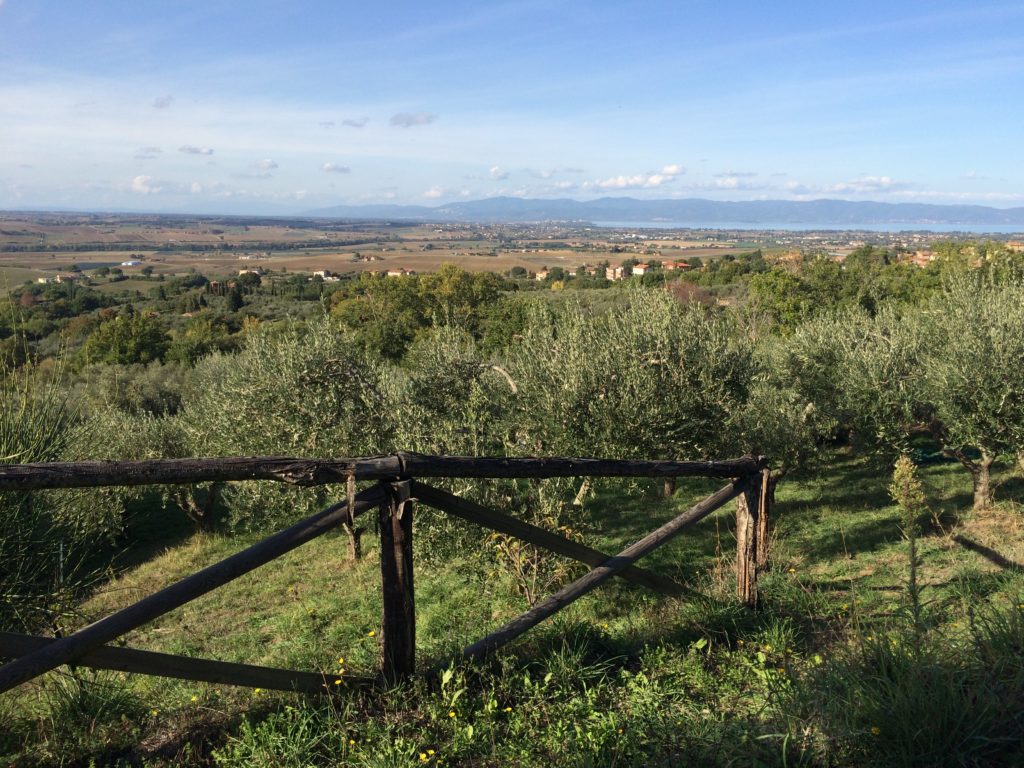
The call goes out to friends to help each other with their harvest. Some people have a few dozen trees, others a few hundred. But regardless, it’s a race against time to get the precious fruit from the tree to the pressing mill before they get a chance to develop mould. The weather is watched closely. You can’t pick when it is too damp. Conditions must be just right.
The morning breaks blue, clear, promising. It’s a ‘go’. Peter and I don our garden clothes, gather our well worn gloves, our goggles (or in my case, sunglasses since la bella figura must be respected at all times) and hats and off we go, ready for a day of olive picking.
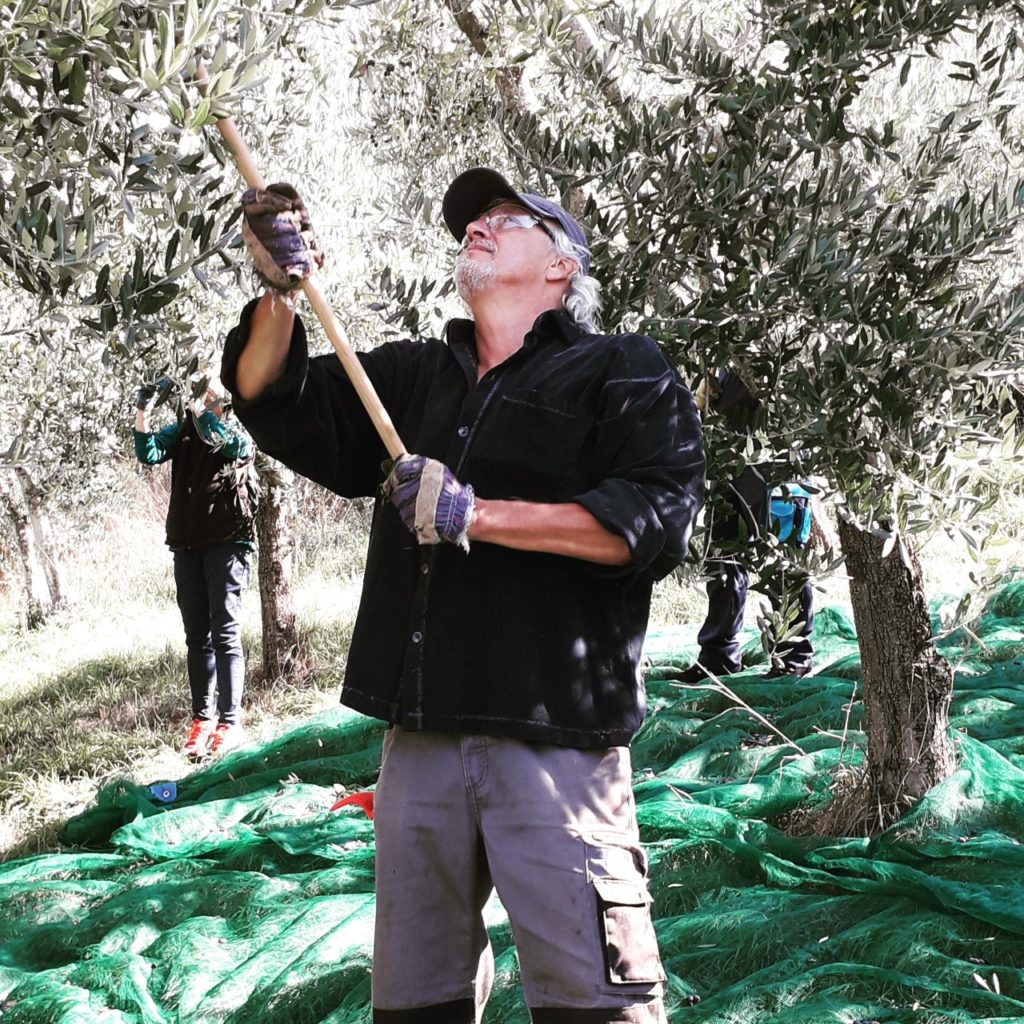
It’s always a group decision as to which tree we work on first, then which will be the next. We help spread the net under the tree, careful to make sure there are no gaps into which our bounty can escape. My favorite place is on the ground, tucked underneath heavily laden branches, surrounded by the inescapable scent of a ripe olive tree. I wish I could bottle the perfume. It’s at once sweet, earthy and peppery – intensely aromatic.
I close my eyes and tilt my head back to face the sun – and breathe. Deeply. Nothing has the power to clear my head better than this heady scent. I am in my happy place. I gently rake the branches, releasing the plump olives to drop on the net. When the tree is bare, we carefully gather the now heavy net and pour the purple and green fruit into the crates. Then we move on to the next tree. And the next…
In time, we break for lunch. We gather around the table drinking wine and satisfying our honest hunger after a morning’s hard work. Then satiated and content, we head back to the grove.
As the sun begins its descent behind the hills and the crates are now stacked ready to go, we call it a day. Back at home, I peal off my dusty clothes and find a few wayward olives. They’re in my shoes, my shirt pocket, even my bra. I’m reluctant to wash my hands, so strong is the delectable scent of olives. Instead, I hold them up to my face one last time and take a deep breath.
But I know tomorrow will bring another day…and another chance to be in my happy place.
A presto
Anna
p.s. I’d like to take a moment to mention how honored I am to be included in the list of Top 100 Midlife blogs on the web. You can find me at #95. If you get a chance, check out some of the other excellent blogs on this site https://blog.feedspot.com/midlife_blogs/

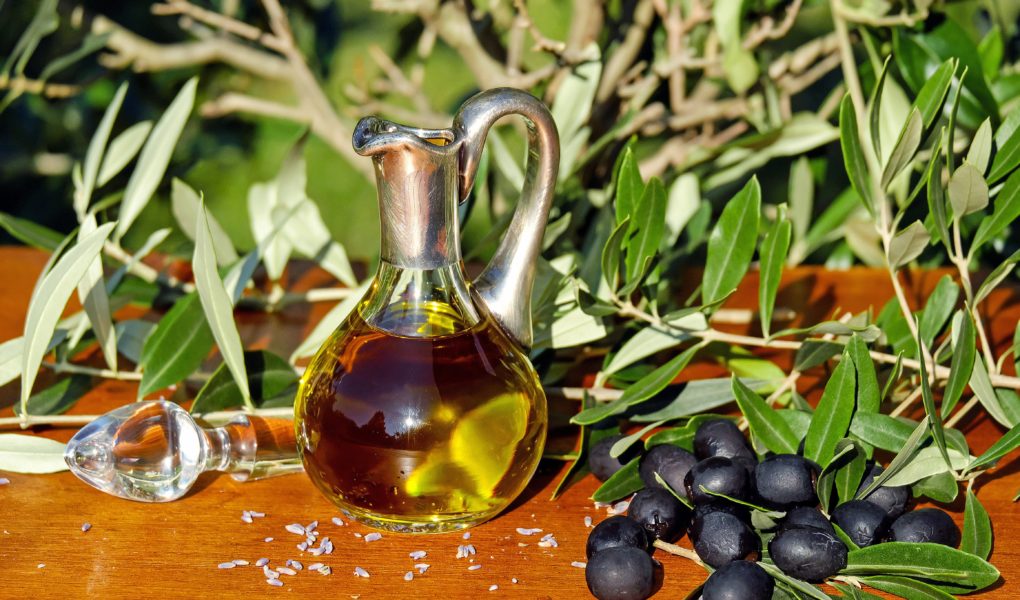

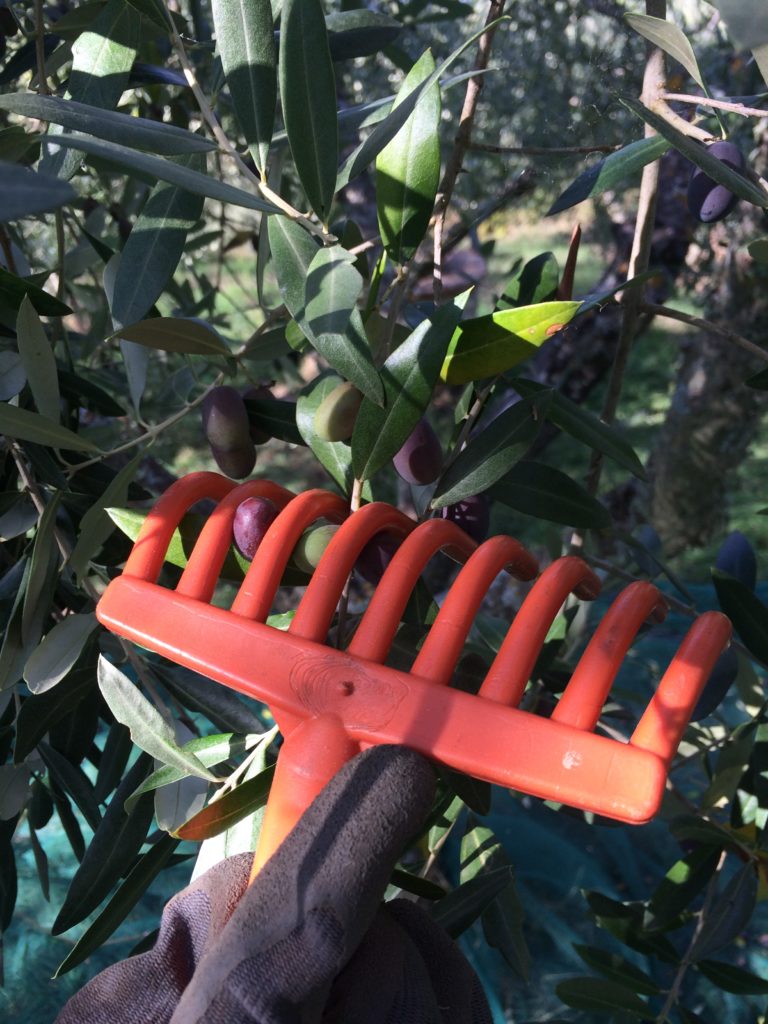
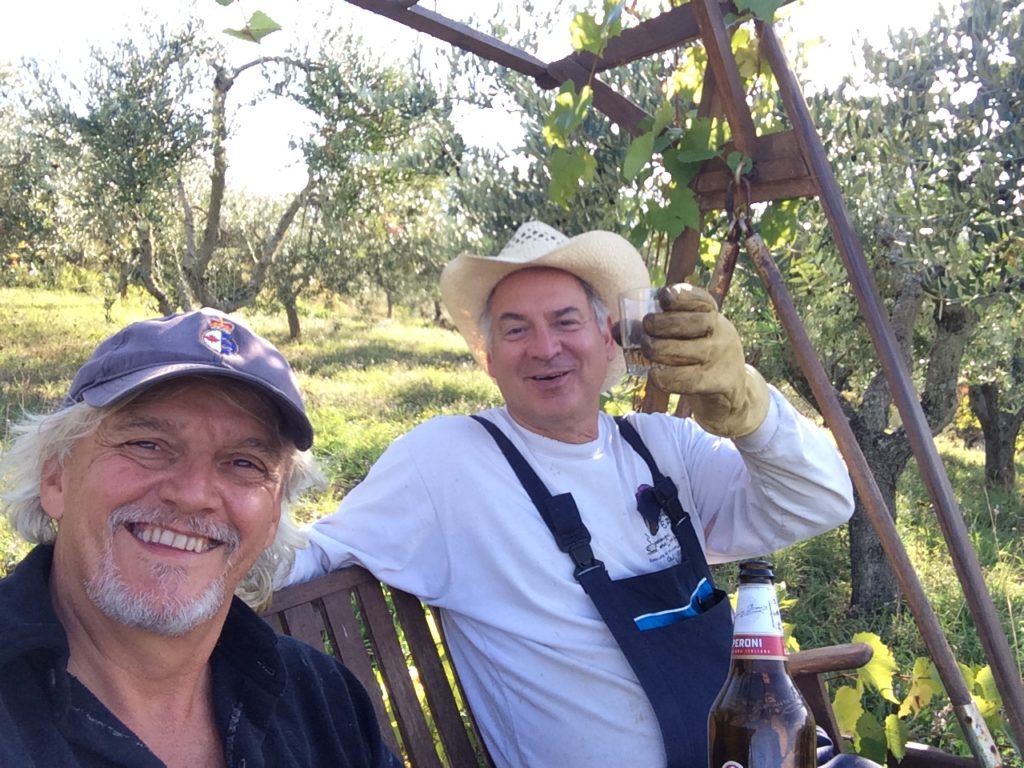
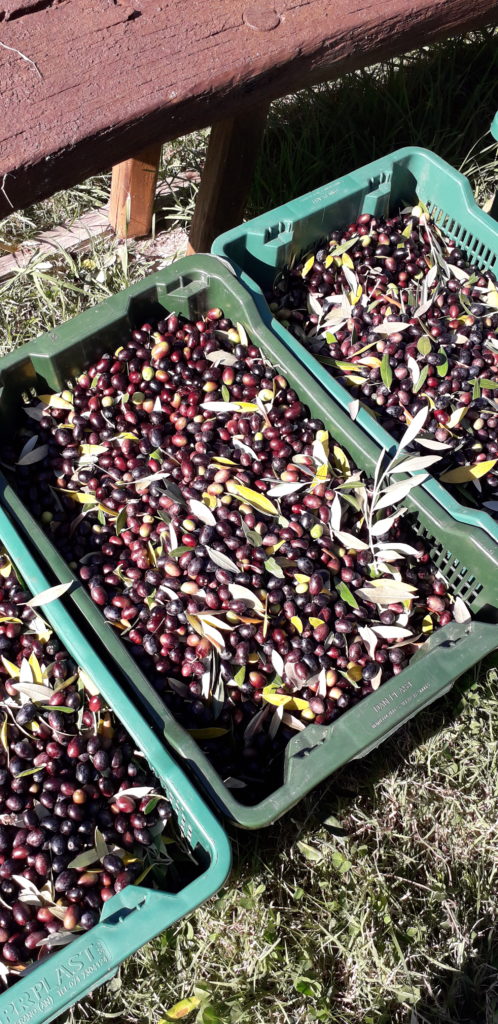
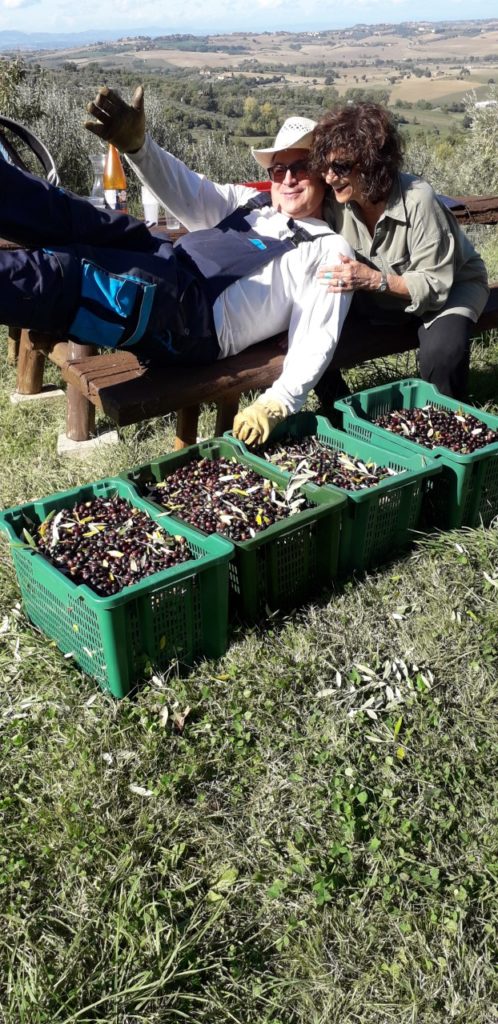



Oh Anna! I loved this. John and I cannot wait to help you with your olive harvest one fall (next?). I’m so drawn to all trees but the olive tree seems particularly special. I had no idea they lived that long. We’ve long finished the olive oil we bought in Umbria and took home with us. It was savoured and enjoyed down to the last drop.
Congratulations on making the top 100! You so deserve it!